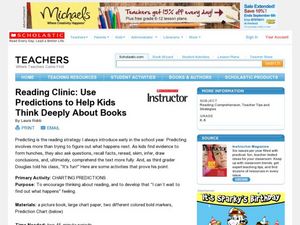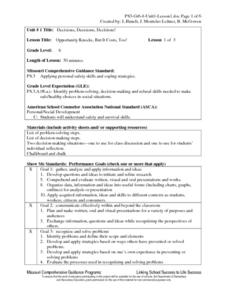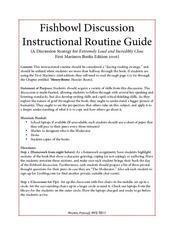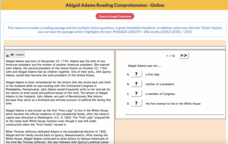Curated OER
"Comprehension of Word Problems" Using a Table
Sixth graders practice solving math problems by utilizing a data table. In this number sense lesson, 6th graders create a table using the numerical information about a fictitious farm's inventory. Students complete the empty segments by...
Curated OER
Read It, Picture It! Reading to Learn
Students examine the reading comprehension strategy of visualization. They practice visualization by making pictures in their mind. They draw the pictures from their visualizations with explanations.
Curated OER
Wood
Students practice reading comprehension strategies. In this literacy and science lesson, students read a non-fiction article about wood and locate main ideas and details. Students construct a card game using information taken from the text.
Curated OER
Butterfly Life
This PowerPoint includes illustrations and explanations of each of the 4 stages in the life of a butterfly. The text provides appropriate reading material for students to practice nonfiction reading comprehension strategies. The text is...
Curated OER
Reading Clinic: Use Predictions to Help Kids Think Deeply About Books
Students learn to use prediction to think more deeply about literature. In this reading comprehension lesson, students chart predictions in order to more fully understand text.
Curated OER
Reading Comprehension Strategy Ideas
Young scholars participate in pre-reading activities, journal keeping, vocabulary lists and other reading comprehension boosters. These activities can be applied to many genres.
Learning Station
Scan It
In this reading strategies worksheet, students will learn how to scan for information. Then students will scan a non-fiction passage about weather and complete 4 short answer questions.
Curated OER
Finders Keepers: Vocabulary Instructional Routine Guide for Extremely Loud and Incredibly Close
Like Oskar, the curious boy in Jonathan Safran Foer’s story, class members journey through other “stories that the mouth can’t tell” to find another sentence that uses a word found in novel. Individuals create their own vocabulary list,...
Curated OER
Opportunity Knocks, But It Costs, Too!
Sixth graders write a reflection piece, outlining each of the decision-making steps they have used and what decision they have decided upon, which includes possible solutions, as well as possible outcomes for each solution. They also...
Curated OER
Extremely Loud and Incredibly Close: Fishbowl Discussion Instructional Routine Guide
What exactly does make life worth living? In preparation for a fishbowl discussion of Extremely Loud & Incredibly Close, readers of Jonathan Safran Foer’s novel highlight sections that show a character grieving, coping, or suffering...
EngageNY
Talking with My Peers: Carousel of Reading Superheroes Around the World
In many places in the world, people go to great lengths to get books to read. This beginning-of-the-year activity uses pictures of people reading in extraordinary situations to stimulate effective listening and speaking using the...
Achievement Strategies
CCSS Unit Design Template for PE
From baseball and tennis to capture the flag and four-square, here is a great document that will help you design your next unit on a sport-related activity.
K12 Reader
Two Viewpoints of the Same Event: Lee Surrenders to Grant, 1865
How did Union General Ulysses S. Grant view the surrender of Confederate General Robert E. Lee in 1865, which effectively ended the United States Civil War? After reading an excerpt from Grant's autobiography, your young historians will...
K12 Reader
Slavery in the Constitution
Your young historians will read excerpts from three parts of the United States Constitution—Article One, the Thirteenth Amendment, and the Fourteenth Amendment—and discuss how they each address the issue of slavery.
E Reading Worksheets
Making Predictions #1
How can you tell what is going to happen next in a story? Learn to make predictions with five sections of stories. Kids read the beginning, and then write what they believe will happen next. Additionally, they provide evidence for their...
E Reading Worksheets
Making Predictions #4
Show young readers how to use evidence from the text in an activity about making predictions. After reading five short passages, kids note what they think will happen next based on what they have read, and include the evidence that...
E Reading Worksheets
Predictions Reading into the Future
Practice making inferences about fiction with a language arts slide show presentation. After kids read a few tips about ways to predict the next event in a story, they read several passages and try to find out what will happen next based...
E Reading Worksheets
Making Predictions #3
Sometimes it's helpful for kids to predict what is coming next when reading a story. Show your learners how to use evidence from the text they are reading to predict what happens next in five short passages.
Mr. Nussbaum
The Color Green
A two-paragraph informative text takes a close look at the color green. Scholars listen to and or read the passage, then answer five multiple-choice questions. A progress report details learners' performance.
Mr. Nussbaum
Old Man of the Mountain
Young scholars read or listen to an informative text about a rock formation in New Hampshire. Following the reading, pupils answer five multiple-choice questions. A detailed progress report appears when class members complete the...
Mr. Nussbaum
Buffalo
Scholars read or listen to an informational text about buffalos, then answer 10 questions—a progress report details participants' work.
Mr. Nussbaum
Silk Road
Challenge pupils to read informational text about the Silk Road. Scholars then take their newfound knowledge to answer a mix of eight fill-in-the-blank and multiple-choice questions. Report details appear at the end.
Mr. Nussbaum
Abigail Adams
Ten multiple-choice questions follow a short informative reading about Abigail Adams. Feedback appears instantly and ends with a detailed report.
Mr. Nussbaum
Arctic Fox
A short informative text shares details about the Arctic Fox. Scholars read or listen to the text then answer 10 multiple-choice questions.
Other popular searches
- Comprehension Strategies
- Active Listening Strategies
- Comprehension Strategies 1st
- Listening Skill Strategies
- Listening Strategies

























